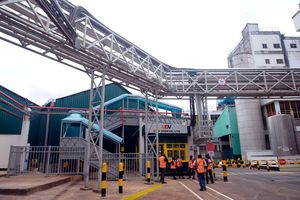Premium
SpaceX to build craft for moon tours

In this image released by NASA, a SpaceX Falcon 9 rocket with the company's Crew Dragon spacecraft onboard is rolled out of the horizontal integration facility at Launch Complex 39A during preparations for the Crew-2 mission, on April 16, 2021, at Kennedy Space Center in Florida.
Nasa on Friday selected Elon Musk’s SpaceX to build spacecraft that would land astronauts on the moon for the first time since the last Apollo mission. The award to SpaceX for the “human landing system” was a stunning announcement that marked another major victory for the hard-charging company that vaults it to the top tier of America’s aerospace companies and solidifies it as one of the space agency’s most trusted partners.
In winning the $2.9 billion contract, SpaceX beat out Jeff Bezos’s Blue Origin, which had formed what it called a “national team” by partnering with aerospace giants Lockheed Martin, Northrop Grumman and Draper. SpaceX also won over Dynetics, a defense contractor based in Huntsville, Ala.
Nasa had originally chosen all three companies for the initial phase of the contract, and was expected to choose two of them to build the lunar lander. In other major programmes, Nasa has chosen multiple providers to foster competition and to ensure it has redundancy in case one can’t deliver.
In a document explaining Nasa’s rationale for picking SpaceX obtained by The Washington Post, Nasa said it wanted “to preserve a competitive environment at this stage of the HLS Programme”.
But it added that “Nasa’s current fiscal year budget did not support even a single (contract) award”. As a result, SpaceX updated its payment schedule so that it now fits “within Nasa’s current budget”.
But in moving ahead with SpaceX alone, it sent a message that it fully trusts the growing company to fly its astronauts for its signature human exploration programme — Artemis, a campaign to return astronauts to the moon for the first time since 1972.
First human lunar lander
“As the first human lunar lander in 50 years, this innovative human landing system will be a hallmark in space exploration history,” Lisa Watson-Morgan, Nasa’s lunar lander programme manager, said during a news briefing announcing the award. “Nasa’s Apollo programme captured the world’s attention, demonstrated the power of America’s vision and technology, and can-do spirit. And we expect Artemis will similarly inspire great achievements, innovation and scientific discoveries. We’re confident in Nasa’s partnership with SpaceX to help us achieve the Artemis mission.”
Over the past several years, SpaceX, founded by Musk in 2002 with the goal of eventually flying humans to Mars, has completely upended the space industry, moving through fast, and at times fiery test campaigns that have unsettled traditional industry officials but also ignited new waves of enthusiasm not seen since the early days of the Space Age.
When Musk first started the company, even he didn’t think it would succeed. In 2008, after three test flights of its Falcon 1 rocket failed to reach orbit, he was nearly out of money. But the next test was successful, and Nasa awarded the company a modest contract that kept it afloat.
In the years since, SpaceX has flown cargo and supplies to the International Space Station, and then, astronauts, overcoming skeptics who said human spaceflight should never be outsourced to the private sector, and certainly not to a company as green — and brash — as SpaceX.
In 2015, one of its Falcon 9 rockets exploded on a mission for Nasa flying cargo to the station. Another exploded on the launchpad ahead of an engine test in 2016. And after Musk smoked pot on a podcast broadcast on the Internet, then-Nasa Administrator Jim Bridenstine ordered a safety review of the entire company.
But despite the setbacks, SpaceX has achieved enormous success — flying astronauts safely and dominating the launch market, while lowering the cost and dramatically increasing the number of flights.
For the Artemis programme, SpaceX bid its reusable Starship spacecraft, which is being designed to fly large numbers of people into deep space and land on celestial bodies as well as back on Earth.
On Twitter, the company said it is “humbled to help @NasaArtemis usher in a new era of human space exploration”. Blue Origin and Dynetics did not respond to requests for comment.
The company has been putting its Starship spacecraft through a fast-paced test campaign at its facility in South Texas, launching prototypes without any people on board several miles up in the air, then flying them back to a landing site.
So far, all the test vehicles have crash-landed in a series of fireballs that triggered investigations overseen by the Federal Aviation Administration. But the company is expected to try again soon with a test vehicle that Musk has said is outfitted with several upgrades. And it hopes to be able to fly the spacecraft to orbit this year.
Test mission
SpaceX was one of two providers hired by NASA to fly its astronauts to the International Space Station. It flew two missions with astronauts last year and its next mission scheduled to launch on Thursday. Boeing, the other company hired to ferry crews to the station and back, has stumbled badly and has yet to fly a test mission with astronauts.
That experience shows why Nasa is best served by having at least two providers on major programmes, officials said, and the pressure will be on SpaceX to perform.
According to the document explaining the decision, SpaceX’s bid “was the lowest among the offerors by a wide margin”. Nasa also liked Starship’s ability to ferry a lot of cargo to and from the surface of the moon as well, which it said “has the potential to greatly improve scientific operations”.
While the contract will cover the first human landing, Watson-Morgan said Nasa “will also begin work immediately on a follow-up competition” to “provide regularly recurring services to the lunar surface that will enable these crewed missions on sustainable basis”.
The Washington Post




